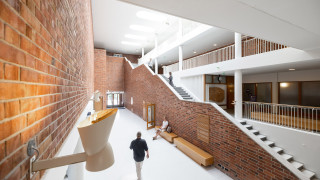Diverse science programme attracted over 12,000 visitors to Researchers’ Night!

This year’s Researchers’ Night has an overarching theme of community, evident in the close collaboration between JYU, Jamk and the City of Light. The CETUS project brought whales to Jyväsjärvi, drawing large crowds to the Ylistö bridge to see their ethereal dance. Despite the congestion on the Ylistö bridge, the physics, chemistry, biology and nanoscience programme in Ylistönrinne attracted the largest crowd on Researchers’ Night. Of particular interest to the public this year were the magnetic simulation of the cerebral cortex in Liikunta, the robot desk in Agora, and the treasures of the Kanavuori cave system.
JYU workshops aimed at schoolchildren proved popular once again with nearly 900 pupils getting the chance to investigate a crime scene, experiment with generative artificial intelligence, and experience chemistry in a new way. A total of almost 12,000 people participated in the event at JYU.
“This year, we had a record number of activities at the university, with over 90 different programme elements,” says Head of Communications Liisa Harjula. “It is great that the audience found our versatile offering.”
“One group was particularly interested in the academic fraud literature that we presented during the tour. They began discussing how similar biographical frauds also occur in the business world,” says Information Specialist Outi Montonen-Guillou. “One visitor said he could have spent the whole day in the Kanavuori caves.”
“The participants of the brain research programme had only positive reactions,” says Doctoral Researcher Vesa Onnia. “The most memorable part was discussing the magnetic stimulation method and its potential benefits with the participants. Researchers’ Night provides an opportunity to remove the barriers between researchers and the general public. In my opinion, it benefits the entire scientific community if people develop a positive image of research and researchers.”
The event at Jamk was attended by families

Held at Jamk for the first time, the event attracted hundreds of visitors. All activity points were filled evenly with participants, many of whom had not previously visited the Jamk main campus. The children were particularly interested in the gathering of family superpowers, as well as the music and frog instrument workshops. There was a lot of interest in the technology laboratories, which featured the hydrogen-powered remote-controlled cars, microalgae and holograms. Dozens of people gathered to watch demonstrations on the strength of materials and thin films.
Different lifestyles and everyday choices were discussed at Jamk in a hands-on workshop related to the development of the HappyPlant app. At various activity points, children had the opportunity to reflect on their leisure activities and breakfast choices as well as on relaxation and recovery. The app is still in the development phase, which disappointed some children as it is not yet available.
“Children’s feedback and answers are delightfully straightforward and honest,” says Fitness Test Coordinator Heidi Lindfors. “Conversations about breakfast or free time may have been a bit different here than at home. Parents smiled and raised their eyebrows when their children told what they eat for breakfast or how much they play. One of our goals was to encourage families to think about and maybe adjust their daily choices. Discussing with children was great fun, and it was wonderful to see how keenly they participated in the motor skills track.”
Jamk’s esports facility GamePit Pro was full for almost the entire evening. Some started their round from here and then returned at the end.
“We had good discussions with parents about competitive gaming and the various educational and career opportunities available in the gaming industry, while the adolescents focused on a wide range of gaming activities,” says Senior Advisor Hanna Hauvala. “Esports, and gaming technologies in particular, offer many research and development opportunities that many companies and members of the public do not yet fully understand.”
This was the tenth anniversary of the science event in Jyväskylä. The Europe-wide science event showcased research to the public across Finland, with events taking place also in Hämeenlinna, Oulu and Helsinki.




